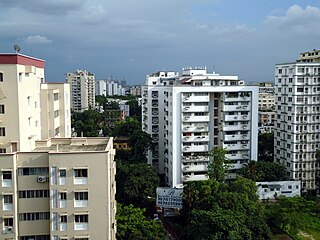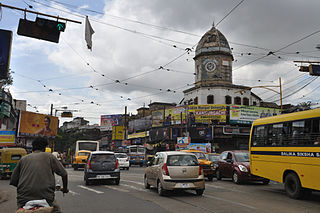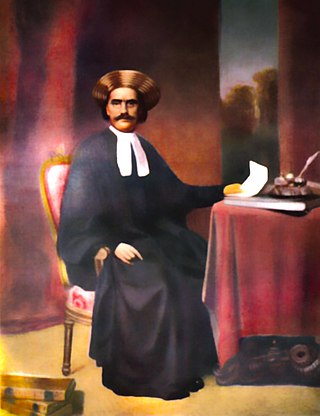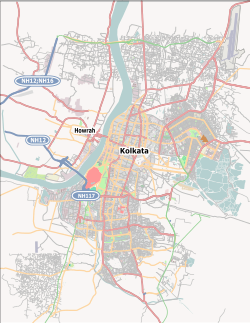Jorasanko Thakur Bari in Jorasanko, North Kolkata, West Bengal, India, is the ancestral home of the Tagore family. It is the birthplace of poet Rabindranath Tagore and the host of the Rabindra Bharati University campus.

Ballygunge is a locality of South Kolkata in Kolkata district, West Bengal, India.

Maniktala is a residential area of North Kolkata, in Kolkata district, West Bengal, India.

Sambhunath Pandit (1820–1867) was the first Indian to become judge of Calcutta High Court in 1863. He served in that position from 1863 to 1867.
The Thakur family, with over three hundred years of history, has been one of the leading families of Calcutta, India, and is regarded as one of the key influencers during the Bengali Renaissance. The family has produced several persons who have contributed substantially in the fields of business, social and religious reformation, literature, art and music.

Lalbazar is a neighbourhood in Central Kolkata, earlier known as Calcutta, in the Indian state of West Bengal. It is part of the central business district adjoining B.B.D. Bagh area. The headquarters of the Kolkata Police is located here and is popularly known by the same name.

Chitpur is a neighbourhood in North Kolkata in Kolkata district in the Indian state of West Bengal. Sometimes, the entire area along Chitpur Road is referred to as Chitpur, although the various localities have distinctive names.

Jyotirindranath Tagore was a playwright, a musician, an editor and a painter. He played a major role in the flowering of the talents of his younger brother, the first non-European Nobel Prize winner, Rabindranath Tagore.

Kumortuli is a traditional potters' quarter in northern Kolkata, West Bengal, India. The city is renowned for its sculpting prowess. It not only manufactures clay idols for various festivals but also regularly exports them.

Pathuriaghata is a neighbourhood of North Kolkata in Kolkata district, in the Indian state of West Bengal. It is one of the oldest residential areas in what was Sutanuti. Once the abode of the Bengali rich, the neighbourhood and its surrounding areas are now dominated by Marwaris. Even in the 21st century the area is replete with colonnaded mansions.

Bagbazar is a neighbourhood of North Kolkata, in Kolkata district in the Indian state of West Bengal. The area, under Shyampukur police station of Kolkata Police, has been, along with neighbouring Shyambazar, the citadel of the Bengali aristocracy. Bagbazar has played an active role in growth and development of Kolkata.

Bowbazar is a neighbourhood of Central Kolkata, in Kolkata district in the Indian state of West Bengal.

Taltala is a neighbourhood in Central Kolkata, in Kolkata district in the Indian state of West Bengal. One of the oldest neighbourhoods of the metropolis, it has a police station on its own name.
Ward No. 23, Kolkata Municipal Corporation is an administrative division of Kolkata Municipal Corporation in Borough No. 4, covering parts of Posta and Jorasanko neighbourhoods in North Kolkata, in the Indian state of West Bengal.
Ward No. 26, Kolkata Municipal Corporation is an administrative division of Kolkata Municipal Corporation in Borough No. 4, covering parts of Ramdulal Sarkar Street and Hedua Park neighbourhoods in North Kolkata, in the Indian state of West Bengal.
Ward No. 41, Kolkata Municipal Corporation is an administrative division of Kolkata Municipal Corporation in Borough No. 5, covering parts of Jorasanko neighbourhood in North Kolkata, in the Indian state of West Bengal.
Ward No. 42, Kolkata Municipal Corporation is an administrative division of Kolkata Municipal Corporation in Borough No. 5, covering parts of Burrabazar neighbourhood in North Kolkata, in the Indian state of West Bengal.
Ward No. 46, Kolkata Municipal Corporation is an administrative division of Kolkata Municipal Corporation in Borough No. 6, covering parts of Chowringhee, Esplanade East, Dharmatala, Janbazar, Lalbazar, Bowbazar and Maidan neighbourhoods in central Kolkata, in the Indian state of West Bengal.
Dihi Panchannagram was a group of 55 villages which the East India Company purchased in 1758 from Mir Jafar, after the fall of Siraj-ud-daulah, the last independent Nawab of Bengal, in what is now the city of Kolkata, earlier known as Calcutta, in Kolkata district, in the Indian state of West Bengal. These villages initially developed as suburbs of Kolkata, but now forms part of the city proper within the limits of the Kolkata Municipal Corporation.
Narkeldanga is a neighbourhood in North Kolkata in Kolkata district in the Indian state of West Bengal.


















